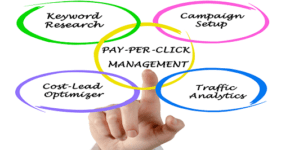Create a Marketing Brochure That Gets Results
Brochures are a valuable marketing tool for businesses. They can be single- or multi-folded pieces of paper, and their sizes and shapes vary. However, with the rise of the digital age, there are also digital variants (most often resembling a pamphlet or an A4-size piece of paper.)
Brochures are often used interchangeably with pamphlets and can be found in various fold types, including the single-fold variety shown above and the bi-fold and tri-fold varieties.
Here are some pointers for creating a marketing brochure that gets read
When it comes to modern advertising, brochures are often overlooked. Video, internet searches, and social media consume most advertising budgets.
However, brochures are more common than you might think in marketing.
Brochures are widely available:
- In the waiting room of your clinic, trying to sell you something.
- When staying at hotels that feature excursions in and around a specific city.
- In large, eye-catching displays at trade show booths.
All kinds of advertisements, from those for high-end real estate to those for small-town service providers, will crowd your mailbox.
Or a brochure was included in your most recent online order’s packaging. To encourage customers to buy from them again, many businesses include brochures in their shipping materials.
Brochures are helpful for both business-to-business and business-to-consumer marketing. In addition, a brochure that has been professionally designed and printed gives the impression that your business is sophisticated and trustworthy.
You can diversify and boost your marketing efforts by adding a printed brochure to your online presence.
The Purpose of a Marketing Brochure
Only promoting a company’s goods and services should be the goal of a marketing brochure.
A brochure can be folded into trifold, z-fold, or bi-fold configurations for promoting goods and services. Brochures are a common form of advertising because they are easily transportable, can be used in various settings, and are brief (a few hundred words). Some brochures out there look more like glossy magazines than brochures.
Advertisements on billboards and television commercials are not within the budget of every business. Brochures, however, are cheap and are therefore used by businesses of all sizes, from the corner pizzeria to the fledgling startup to the multinational conglomerate.
The copy on your marketing brochure is essential, as it can bring in a lot of new business if it is well done.
Which Are A Pamphlet And A Brochure?
Compared to pamphlets, which are typically just one page long, brochures can span several. Pamphlets are typically made to disseminate information, while brochures promote a product or service.
Brochures, however, can have many pages and are therefore bound.
Is It Necessary To Print A Brochure For Your Business?
Brochures are one of the oldest forms of advertising.
However, even though digital marketing strategies are where it’s at in terms of popularity, tried and proper methods like the brochure are here to stay.
Physical promotional materials might be more effective than ever. One market research firm has found that tangible media, as opposed to digital media, is more likely to be remembered, persuasive, and ultimately effective at changing consumer behaviour.
Flyers, brochures, and posters are just as important as websites and social media graphics, and the best modern marketing strategies take advantage of both.
This article will provide eight professional brochure writing tips to increase your sales and attract your target demographic.
Determine Your Brochure’s Intended Audience.
It’s essential first to define your target audience and objectives before you even begin to consider the layout of your brochure.
A marketing brochure, like any other form of promotional literature, needs to:
- They are designed to appeal to a particular subset of your target audience while influencing a predetermined set of KPIs.
- Your brochure’s copy and visuals should be tailored to appeal to a specific demographic, whether that be by age, buying cycle, income level, geographic region, or preferred way of life. Positioning and messaging are two areas where user personas prove helpful.
So, knowing your intended audience is crucial before beginning work on a marketing brochure.
The next step is to settle on a single, quantifiable goal for your brochure’s promotion. It would be best if you got people to do something after reading your brochure, whether visiting your store or signing up for your email list. The end goal is to increase your lead generation.
Determining the desired course of action will allow you to craft more effective and helpful copy. Here are some instances:
- You’re hoping to schedule more appointments for your service consultations. Your brochure should highlight the benefits of the consultation and provide the necessary booking information.
- You want to encourage people to stop at your upcoming trade show booth. A new product you plan to sell at the show could be featured in your brochure, and a discount could be offered to attendees who redeem the coupon while supplies last. Get them quickly by using our simple online voucher generator.
- You need traffic if you want to see success with your shiny new online store. Consider including a discount code in your brochure to attract first-time customers.
However, a clear goal is essential for developing an effective marketing brochure. Pay attention to the specific needs of a subset of your target audience and, if possible, push for just one call to action.
Write Thoughtful, Targeted Text For Your Marketing Brochure
After you’ve narrowed your focus, it’s time to put pen to paper.
This copywriting process needs to be directed by the brochure’s structure. You’ll need to divide your content between the brochure’s front, centre, and back pages.
A straightforward message needs to be communicated on the front page.
Your brochure’s cover page should immediately intrigue the reader. Everything on that page must be compelling enough for them to want to turn the page. Do your best to convey your message with as few words as possible on the front page.
A useful guideline? Be sure to keep the headline copy to under 25 words. A brochure’s primary information must be easy to read and digest.
So, now that we’ve covered the cover let’s dive into the brochure’s meat and potatoes. If you’ve managed to pique your readers’ interest, it’s time to give them what they came for: details about your offerings.
● Make Use Of Headers To Advertise Your Products And Services Immediately.
Each business offering or product feature should be stated clearly and briefly in the headers so that readers can see what you’re selling at a glance. These headings must convey meaning without any additional context.
● Support Your Headers With Brief Explanations.
Underneath each heading, you should explain the offering at hand more thoroughly. Please be as concise and direct as possible in your explanations. Provide enough detail to pique your readers’ interest before sending them to your website or store for more.
When possible, use charts and graphs to back up your design.
Use less space to explain numbers, percentages, or survey outcomes. Information presented in the form of charts and graphs is both more understandable and aesthetically pleasing. They convey your message clearly and effectively while taking up less room on your brochure.
● Provide Them With The Necessary Information To Purchase From You
Additional information, such as a phone number, should be included on the brochure’s back.
After describing your products and services, give the customer all the information they need to purchase from you. This includes your email address, physical location, and a link to your website. You can put this section at the end; after all your convincing, your reader will naturally turn to the back of the book to look it up.
Including pricing information here is a good idea, but you can include anything you like as long as it has a descriptive heading and is no longer than a paragraph. A QR code would be a great way to get your readers interested in what you say.
Develop An Outline
The key to success is anticipating what you want and working toward it. The time and effort spent on brainstorming and creating an outline for the content and layout of your brochure will be well worth it.
For a quick refresher on what should be in your brochure, consider the following:
- The brand’s name and logo are prominently displayed on the front panels.
- Your best product information and sales pitch are contained within the inner panels.
- The last or back panel is where you can include a call to action, your contact information, and any other pertinent details.
- Plan your brochure around the AIDA framework (attention, interest, desire, and action).
Writing a marketing brochure is much less daunting if you have a game plan before you start.
Concentrate On Your Readers
The primary purpose of many brochures is to promote the company’s image.
While it is essential to promote the company, the primary goal of a marketing brochure is to communicate with the target audience. Readers will quickly lose interest if you don’t address their problems and explain how your business will solve them.
Pose the questions:
- Why on earth would you want to read this?
- Who exactly is benefiting from this, exactly?
Customers are highly likely to buy from you if you show them that you care about them and their problems rather than just pushing your product.
Employ Correct Formatting
You can only expect your marketing brochure to be successful if it’s formatted correctly. The brochure is much easier to read now that it has been formatted correctly. In addition, brochures are rarely read from cover to cover. It’s more efficient for them to scan them for the most relevant details.
How to make your brochure easier to read and scan:
- Use Bullet Points to Summarize Longer Descriptions
- Use short, to-the-point headings and descriptions to support them.
- Communicate Clearly. Straightforward, conversational writing attracts readers from all walks of life.
- Make Eye-Catching Subheadings. Use headings to highlight your primary arguments and services. Most readers will focus on these sections, and they may be the only ones.
Avoid using technical terms and complex sentences that may be lost on some readers. The writing needs to be formal while still being understandable.
Include a Straightforward Call-to-Action
Surprising as it may sound, many brochures don’t have a call to action (call to action).
Why bother handing out a marketing brochure if you aren’t going to try to make a sale?
Before writing your brochure, ensure you know exactly what you want to achieve.
Walk your readers through a journey of their hurt feelings. Then, provide a call to action that instructs them on what they should do next to address their concern. Make the brochure worth the reader’s time and effort to keep.
Examples of calls to action (CTAs) for generating sales are provided below:
- Just click the button below to begin your risk-free trial.
- Start Now
- Launch in 1 Minute
- Invest Immediately
- Invest Later
- Get a treat
- Make a reservation
- We offer a free trial membership where you can shop and place orders for 30 days.
- Acquire the attitude
- Make a bargain
- Look at the alternatives
- Get your money now
- Put money away today
- Get started putting money away
- Take advantage of this coupon offer
- Now saving you 30%
- Get special offer
- Free shipping for a limited time.
Download-focused call-to-action examples:
- Right this minute
- Free ebook download
- Unlimited access
- No catch
- Try looking at some examples
- Review the sample case
- Take advantage of the free resources
- Get a copy right now
- Put down the books
- Learn this right now
- Request a Quote
- Download this free checklist
- Start your first class today
- Check out my free materials
- Get my findings to me
When you want readers to get in touch with you, here are some examples of calls to action:
- Get in touch
- Talk to a sales rep
- Choose to call with a tap
- Get in touch for details
- Ask for a price quote
- Ask for an invitation
- Obtain a no-cost estimate
- Seek Appraisal
- Inquire Now
- Set up a meeting
- See if We’re Available
- Arrange a Presentation
- Consult with a Pro
- Book a Call
- Get a free consultation by setting up a discovery call.
Here are some call-to-action samples for when you want people to register for your newsletter:
- Learn the most recent information
- Find out before anyone else
- The signup process is quick and easy
- Have access now.
- Be sure to keep me updated
- Join us now
- Be a part of our mission
- Be a part of the revolution
- Be a part of the fun
- Be a part of our exclusive community
- Be a part of our 5,000+ subscribers
- Be a VIP
- Discover our secrets
Remember to include clear instructions on contacting you or what to do after your call to action. At least in a printed brochure, they can’t just open a link and be taken to another website.
Check out our article about increasing newsletter subscriptions to complement the development of your brochure marketing.
Check Your Brochure For Errors
Proofreading and editing is the final and most important stage of creating a marketing brochure. It is crucial that your marketing brochure is error-free and effectively communicates your message.
Why? Because the cost of reprinting your brochure would be prohibitive at this point.
Imagine being at a trade show with dozens of your colleagues and hundreds of potential customers when one of them notices a spelling mistake on the cover of your brochure. Avoid that type of social faux pas by having your work proofread.
It’s also not a good idea to check your team’s brochure for errors on your own. This is because it is challenging to spot your own mistakes.
The best way to ensure your brochure is free of typos is to have someone else read it and provide feedback.
Design The Brochure With Your Text, Images, And Logo In Mind.
Making a brochure to advertise your business is the final step. It’s tempting to choose a template based on its aesthetic appeal, but it’ll save you a lot of time and effort if you instead choose one based on its compatibility with your content (and you can change up the fonts and colours at the end).
After you’ve found the one you like, please copy and paste your text and replace any stock images with your own.
You can stop working on it now if the layout suits your needs. You’ve just completed your first brochure, so please accept our congratulations.
However, if you find that some of your content doesn’t quite fit, or if you want to add a more personal touch to your brochure design, there are a few key strategies you can employ to guarantee a final product you’ll be pleased with.
● Align The Content In The Centre Of Each Section.
If you want the text in each of the brochure’s six sections to look good, centre it horizontally. This gives it some breathing room by keeping it away from the creases of the brochure, which is especially helpful when using trifold or bifold brochure templates.
● Adjust The Proportions Of Your Images.
To give the impression that your image selection was well thought out, you should resize all of the images to the same proportions. Crop them, so they are all the same size, or use a unique shape like a circle.
● Demarcate Each Section With The Help Of Colour And Imagery.
You may feel that your brochure design lacks excitement once you’ve added text and images to the page. Try changing the background colour or adding an image to spice things up. Use large images in the backgrounds of some sections while leaving others blank to delineate the sections:
● Only Two Or Three Colours Are Acceptable.
Less is better when it comes to choosing a colour palette. Single, striking colours are typical of the brochure designs I find most appealing (occasionally more, but two or three colours at most).
How do you go about selecting the brochure’s colour scheme? Your brand’s colours can play a role here. Use your logo and other branding elements (website, business cards, flyers, etc.) as inspiration if you already have them.
● Design Your Brochure With Some White Space.
Last but not least, remember to incorporate plenty of white space into your brochure layout. You will be tempted to cram as much information as possible onto your page. The content you’ve worked so hard on will shine brightest if you give it some room to breathe.
Conclusion
This may seem like a lot of things to deal with, but being able to design a professional marketing brochure is a crucial skill for any business owner or marketer, and our brochure templates make the process simple.
For more helpful articles, check us out here.




